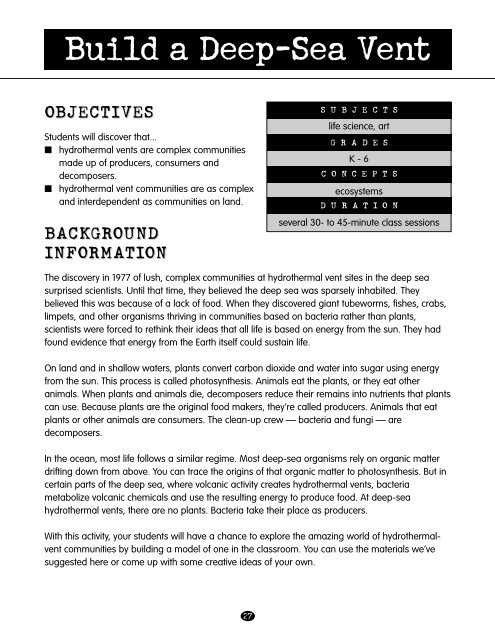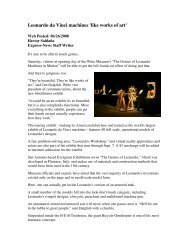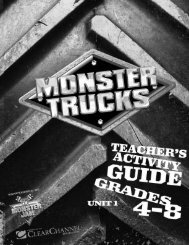Extreme Deep Teacher's Guide.pdf - Evergreen Exhibitions
Extreme Deep Teacher's Guide.pdf - Evergreen Exhibitions
Extreme Deep Teacher's Guide.pdf - Evergreen Exhibitions
Create successful ePaper yourself
Turn your PDF publications into a flip-book with our unique Google optimized e-Paper software.
Build a <strong>Deep</strong>-Sea Vent<br />
OBJECTIVES<br />
Students will discover that...<br />
■ hydrothermal vents are complex communities<br />
made up of producers, consumers and<br />
decomposers.<br />
■ hydrothermal vent communities are as complex<br />
and interdependent as communities on land.<br />
BACK<br />
CKGROUND<br />
INFORMA<br />
RMATION<br />
S U B J E C T S<br />
life science, art<br />
G R A D E S<br />
K - 6<br />
C O N C E P T S<br />
ecosystems<br />
D U R A T I O N<br />
several 30- to 45-minute class sessions<br />
The discovery in 1977 of lush, complex communities at hydrothermal vent sites in the deep sea<br />
surprised scientists. Until that time, they believed the deep sea was sparsely inhabited. They<br />
believed this was because of a lack of food. When they discovered giant tubeworms, fishes, crabs,<br />
limpets, and other organisms thriving in communities based on bacteria rather than plants,<br />
scientists were forced to rethink their ideas that all life is based on energy from the sun. They had<br />
found evidence that energy from the Earth itself could sustain life.<br />
On land and in shallow waters, plants convert carbon dioxide and water into sugar using energy<br />
from the sun. This process is called photosynthesis. Animals eat the plants, or they eat other<br />
animals. When plants and animals die, decomposers reduce their remains into nutrients that plants<br />
can use. Because plants are the original food makers, they’re called producers. Animals that eat<br />
plants or other animals are consumers. The clean-up crew — bacteria and fungi — are<br />
decomposers.<br />
In the ocean, most life follows a similar regime. Most deep-sea organisms rely on organic matter<br />
drifting down from above. You can trace the origins of that organic matter to photosynthesis. But in<br />
certain parts of the deep sea, where volcanic activity creates hydrothermal vents, bacteria<br />
metabolize volcanic chemicals and use the resulting energy to produce food. At deep-sea<br />
hydrothermal vents, there are no plants. Bacteria take their place as producers.<br />
With this activity, your students will have a chance to explore the amazing world of hydrothermalvent<br />
communities by building a model of one in the classroom. You can use the materials we’ve<br />
suggested here or come up with some creative ideas of your own.<br />
27





